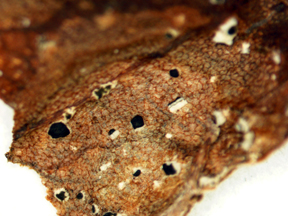Scouting for diseases: Myrothecium leaf spot
Editor’s note: This article is from the archives of the MSU Crop Advisory Team Alerts. Check the label of any pesticide referenced to ensure your use is included.
Pathogen: Myrothecium roridum.
Hosts: Lamium, Molucella, Rudbeckia and Salvia.
Symptoms: This disease causes leaf spots. Concentric
rings may develop in the lesions. Raised, black sporodochia develop on
diseased tissue. In high humidity, the sporodochia are encircled by a
tuft of white growth.
Spread: Spores are splash-dispersed by irrigation water and rainfall.
Management: Avoid injuries to plants. Young or injured tissue
is most susceptible. One common cause of wounding is packaging for
shipping; disease readily develops following shipping. Avoid excessive
fertilization – high fertilizer rates that favor lush foliage growth
have also been associated with disease outbreaks. Reduce periods of leaf
wetness by carefully timing irrigation. Fungicide applications may be
needed to control severe disease problems.
Editor’s note: The information in this article is from MSU Extension publication E-2981, A Pocket Guide for IPM Scouting in Herbaceous Perennials. The publication can be ordered through MSU Extension: http://ipm.msu.edu/perennials.htm



 Print
Print Email
Email


